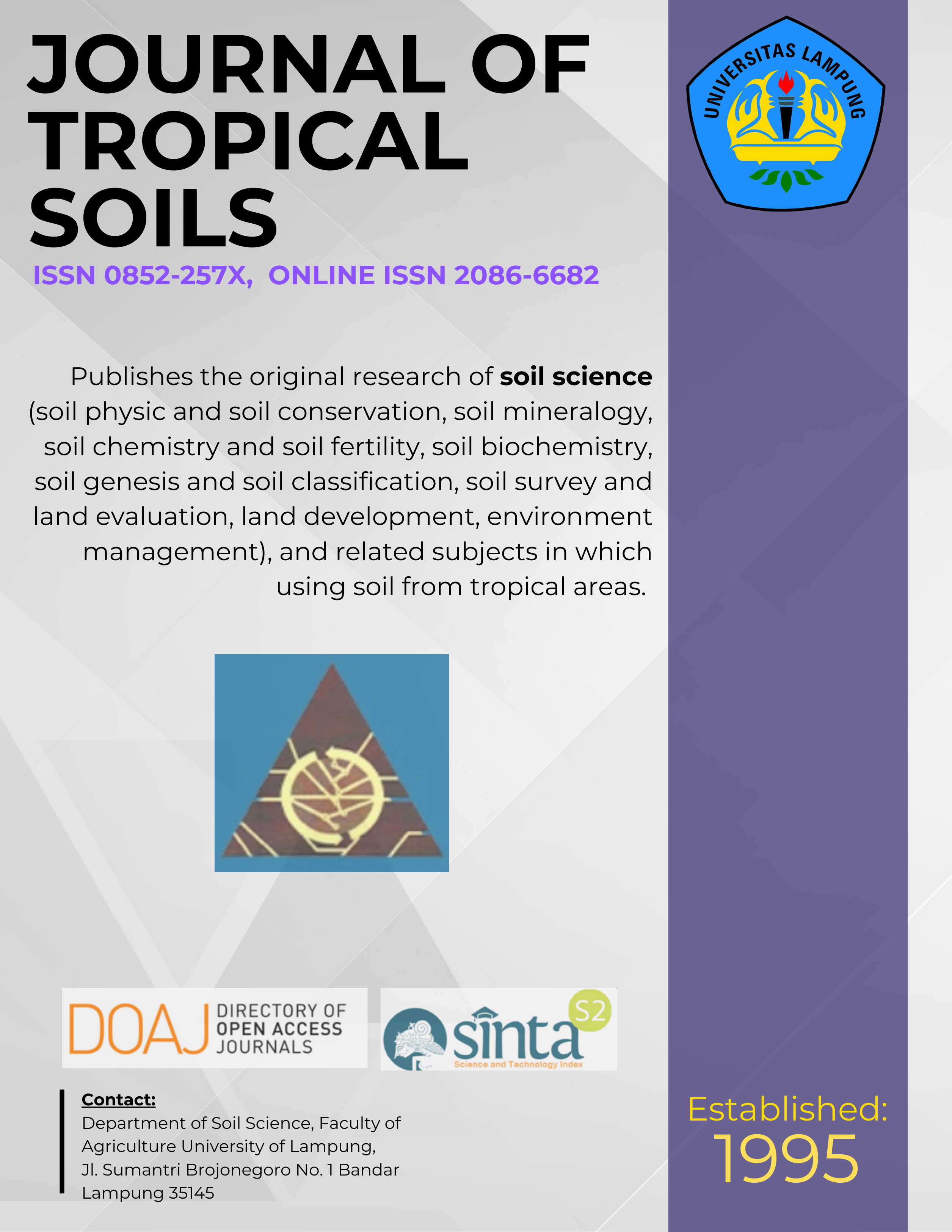Residual Effect of Nitrogen Fertilization on Nitrous Oxide Flux and Yield of Three Cowpea Varieties (Vigna unguiculata L.) in Rainfed Rice Fields
Main Article Content
Abstract
Downloads
Article Details
Issue
Section
License for Authors
Authors who publish with this journal agree to the following terms:
- Authors retain copyright and grant the journal right of first publication with the work simultaneously licensed under a Creative Commons Attribution License that allows others to share the work with an acknowledgement of the work's authorship and initial publication in this journal.
- Authors are able to enter into separate, additional contractual arrangements for the non-exclusive distribution of the journal's published version of the work (e.g., post it to an institutional repository or publish it in a book), with an acknowledgement of its initial publication in this journal.
- Authors are permitted and encouraged to post their work online (e.g., in institutional repositories or on their website) prior to and during the submission process, as it can lead to productive exchanges, as well as earlier and greater citation of published work (See The Effect of Open Access).
License for Regular Users
Other regular users who want to cite, distribute, remix, tweak, and build upon author’s works, even for commercial purposes, should acknowledge the work’s authorship and initial publication in this journal, licensed under a Creative Commons Attribution License.
How to Cite
References
Abalos D, JW van Groenigen and GB De Deyn. 2017. What plant functional traits can reduce nitrous oxide emissions from intensively managed grassland? Global Change Biology 24: 248-258.
Ali W, A Jan, A Hassan, A Abbas, A Hussain, M Ali, SA Zuhair and A Hussain. 2015. Residual effect of preceding legumes and nitrogen levels on subsequent maize. Intern J Agron Agric Res 7: 78-85.
Baruah KK, B Gogoi, P Gogoi and PK Gupta. 2010. N2O emission in relation to plant and soil properties and yield of rice varieties. Agron Sustain Div 30: 733-742.
Cassman KG, A Dobermann and DT Walters. 2002. Agro-ecosystems, nitrogen use efficiency, and nitrogen management. AMBIO: J.Hum Environ 31: 132-138.
Chen D, H Suter, A Islam, R Edis, JR Freney and CN Walker. 2008. Prospects of improving efficiency of fertiliser nitrogen in Australian agriculture: a review of enhanced efficiency fertilisers. Australian J Soil Res 46: 289-301.
Daramy MA, J Sarkodie-Addo and G Dumbuya. 2017. Effect of nitrogen and phosphorus fertilizers application on growth and yield performance of cowpea in Ghana. ARPN J Agric Biol Sci 5: 31-44.
Eviati dan Sulaeman. 2012. Petunjuk Teknis Analisis Kimia Tanah. Tanaman, Air, dan Pupuk. Edisi 2. Badan Penelitian dan Pengembangan Pertanian. Jakarta.
Erythrina. 2016. Bagan warna daun: alat untuk meningkatkan efisiensi pemupukan nitrogen pada tanaman padi. Jurnal Penelitian dan Pengembangan Pertanian 35: 1-10.
IPCC. 2014. 2013 Supplement to the 2006 IPCC Guidelines for National Greenhouse Gas Inventories: Wetlands. Hiraishi T, T Krug, K Tanabe, N Srivastava, J Baasansuren, M Fukuda and TG Troxler. (Eds). Published: IPCC, Switzerland.
Jeuffroy MH, E Baranger, B Carrou´ee, E de Chezelles, M Gosme, C H´enault, A Schneider and P Cellier. 2013. Nitrous oxide emissions from crop rotations including wheat, oilseed rape and dry peas. Biogeosciences 10: 1787-1797.
Kyei-Boachen S, CEN Savala, D Chikoye and R Abaidoo. 2017. Growth and yield response of cowpea to inoculation and phosphorus fertilization in different environments. Front Plant Sci 8: 646.doi.103389/fpls.2017.00646.
Legay N, C Baxendale, K Grigulis, U Krainer, E Kastl, M Schloter, and S Lavorel. 2014. Contribution of above- and below-ground plant traits to the structure and function of grassland soil microbial communities. Annals of Botany 114: 1011-1021.
Lizhi C. 1994. Use of green manure in China as agricultural systems commercialize. pp. 43-50 in Ladha JK and DP Garrity (Eds). Green Manure Production Systems for Asian Ricelands. International Rice Research Institute. Los Banos, Philippines.
Millar N, A Urrea, K Kahmark, L Shcherbak, GP Robertson and I Ortiz-Monasterio. 2018. Nitrous oxide (N2O) flux responds exponentially to nitrogen fertilizer in irrigated wheat in the Yaqui Valley, Mexico. Agric Ecosyst Environ 261: 125-132.
Oke SO and DL Eyitayo. 2010. Growth and yield response of cowpea (Vigna unguiculata L. Walp.) to soils from different fallow physiognomies in the rainforest zone of Nigeria. Acta Bot Croat 69: 291-297.
Rahmadani E dan N Sunarlim. 2013. Pertumbuhan tanaman dan hasil beberapa varietas kacang tunggak (Vigna unguiculata) yang ditanam pada dua populasi tanaman. J Agroteknologi 4: 19-24.
Setyanto P, A Rosenani, AK Makarim, C Fauziah, A Bidin and Suharsih. 2002. Soil controlling factors of methane gas production from flooded rice fields in Pati District, Central Java. Indonesian J Agric Sci 3: 1-11.
Signor D and CEP Cerri. 2013. Nitrous oxide emissions in agricultural soils: A review Pesq Agropec Trop 43: 322-338.
Singh Y, JK Ladha, B Singh and CS Khind. 1994. Management of nutrient yields in green manure systems. pp. 125-153 in Ladha JK and DP Garrity (Eds). Green Manure Production Systems for Asian Ricelands. International Rice Research Institute. Los Banos, Philippines.
Singh U, KC Cassman, JK Ladha and KF Bronson. 1995. Innovative nitrogen management strategies for lowland rice systems. pp. 229-254 in Fragile Lives in Fragile Ecosystems. Proceedings of the International Rice Research Conference, 13-17 February 1995. PO Box 933, Manila, Philippines.
Sumarno and I. Manwan. 1990. National Coordinated Research Program: Grain Legume. Central Research Institute for Food Crops. Bogor.
Wang J, UP Sainju and JL Barsotti. 2012. Residue placement and rate, crop species, and nitrogen fertilization effects on soil greenhouse gas emissions. J Environ Protection 3: 1238-1250.
Wang WJ, NV Halpin, SH Reeves, WE Rehbein and MA Heenan. 2015. Soybean rotation and crop residue management to reduce nitrous oxide emissions from sugarcane soils. Proc Aust Soc Sugar Cane Technol 37: 33-41.

